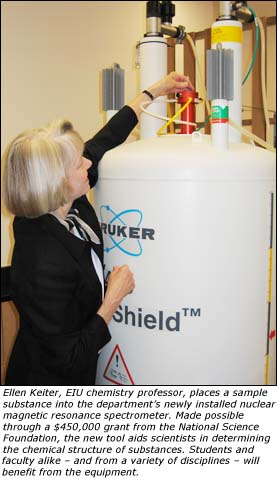Reputation for Faculty/Student Research has its Monetary Benefits
Oct-28-2005  When asked to explain the National Science Foundation’s generosity in awarding Eastern Illinois University a $450,000 grant, Barbara Lawrence says simply, “faculty/student collaboration.”
When asked to explain the National Science Foundation’s generosity in awarding Eastern Illinois University a $450,000 grant, Barbara Lawrence says simply, “faculty/student collaboration.”
The NSF, which has awarded numerous grants over the years to various departments at the Charleston university, acknowledges through its support that when Eastern touts close, personal relationships between faculty and students as one of its major strengths, it’s more than just words.
Lawrence, an associate professor in Eastern’s chemistry department, believes these relationships are why – partially, at least – the foundation funded the purchase of a nuclear magnetic resonance spectrometer to the tune of nearly half a million dollars. Installation of the equipment was completed this past summer, and now EIU students are being trained to use the long-awaited educational tool.
Such knowledge will be invaluable to these students as they graduate and travel further along in their careers.
“Many of our students go on to graduate school or to industries where they will use this type of equipment,” said Ellen Keiter, the chemistry professor who, along with Lawrence, co-wrote the NSF grant application.
“And others on campus from different departments have expressed interest in using it, as well,” she added. “Students from biological sciences already use it.”
Doug Klarup, professor and chair of Eastern’s chemistry department, concurred.
“The department of chemistry is fortunate to have dedicated and capable faculty like Barbara Lawrence and Ellen Keiter,” he said. “Because of their efforts in successfully obtaining this very competitive National Science Foundation grant, Eastern Illinois University chemistry, biology and pre-med students will have access to state-of-the-art NMR instrumentation in laboratory courses and research activities.
“It is a fantastic acquisition for the department and the university.”
Use of the equipment requires a trip to a small third-floor room on the south side of Eastern’s Physical Sciences Building. The sight that first catches one’s eye is a large canister (somewhat resembling a white propane tank cut in half and standing on end), its weight supported by three large, sturdy, black legs. Wires, pipes and other such accompaniments connect the canister to a computer on one side of the room and electrical components located elsewhere nearby.
According to Lawrence and Keiter, the purpose of the equipment is to provide the user with information about the chemical structure of a substance.
For example, one can insert a sample via a pencil-thin test tube into the center of the canister. Then, as that test tube rotates at a high rate of speed (20 rotations per second), a superconducting magnetic coil causes the nuclei in the atoms of the enclosed substance to align, or “stand at attention.” When in position, these nuclei are then “zapped” with radio waves. A scientist can then identify the substance’s molecular composition based on the responses to irradiation.
According to Lawrence, an NMR instrument can be invaluable in a scientist’s work. Practical applications include use by drug companies to test the purity of samples or efforts by lab personnel to confirm the composition of their creations.
On a more personal note, Lawrence plans to use Eastern’s NMR spectrometer to advance her research on spider silk – its strength and elasticity, in particular. Fortunately, the foundation’s generosity will make this possible.
Most chemistry departments the size of Eastern’s have a simpler version of the NMR instrument Eastern purchased, Lawrence said. “Because of the size of the grant, we were able to afford some special modifications.”
In short, she added, this will allow Eastern’s faculty and staff to research solids in addition to just liquids.